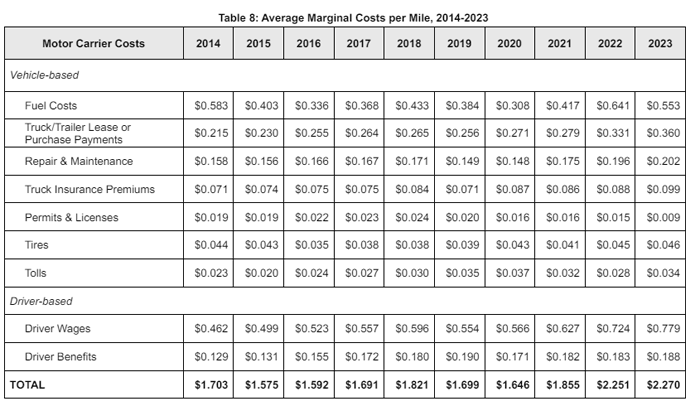The American Transportation Research Institute (ATRI) is fresh out with its annual study on what it costs a US carrier to run a truck. The new report is based on 2023 carrier data, so it's a little dated, but as always provides an interesting snapshot.
Supply Chain Digest Says...
|
 |
| |
Only 12% of respondents used some form of alternative fuel in at least one truck in 2023. Of all alternative fuel types, compressed natural gas (CNG) and battery electric have the highest adoption rate, with 7.3% of respondents having at least one of those types of trucks. |
What do you say? |
| Click here to send us your comments |
 |
| |
|
ATRI issues this analysis every year, starting with 2008. It is based on survey data from carriers and private fleets of all size. However, the survey population has a much higher percentage of LTL truckers (48.0%) vs full truckload than (31.4%) does the overall US trucking industry. Another 20% of participants came from specialized carriers such as flat bed and reefers.
Participation came from a good balance of large, medium and smaller carriers.
Data collection for the report began in February 2024 and ended in May, using a variety of channels and techniques to solicit participation in the survey.
The headline news: The report found that the marginal costs of trucking, while increasing by just 0.8% over the prior year (amid modestly lower fuel costs) reached a new high of $2.27 per mile.
With fuel removed, the marginal cost of trucking rose by 6.6%, from $1.61 per mile in 2022 to $1.716 per mile in 2023.
Marginal operating costs on a per-hour basis were $91.27
.
The table below from the report shows the operating costs per mile by category over the past 10 years.
As can be seen, fuel costs averaged 55 cents per mile in 2023 (24% of the total), while wages accounted for 78 cents (34%) and driver benefits 18 cents (8%).

Source: ATRI
The report collects a lot of other interesting information. For example, the average truck age among respondents dropped from 4.7 years in 2022 to 3.8 years in 2023.
(See More Below)
|
CATEGORY SPONSOR: SOEON |
 |
|
|
There report says that this unusually low average age came after aggressive buying of new trucks in late 2022 and 2023 on the heels of record-high average ages during the parts shortages of 2020 and 2021.
The average number of annual miles driven per truck in 2023 rose for the first time in years, albeit slightly, to 80,159 from 78,863 in 2022. Conversely, the number of days each truck ran decreased from 251 in 2022 to 243 in 2023.
The report also found that on average carriers retired their trucks at about 673,000 miles.
The report also finds that deadhead mileage, a major cost factor, rose to an average of 16.3% for all non-tanker operations, while driver turnover rose by 5 percentage points in the truckload sector.
Only 12% of respondents used some form of alternative fuel in at least one truck in 2023. Of all alternative fuel types, compressed natural gas (CNG) and battery electric have the highest adoption rate, with 7.3% of respondents having at least one of those types of trucks.
But the level of alternative fuel adoption remains limited – and concentrated. Almost all fleets that use alternative fuels in do so only in a very small number of trucks, the report says. However, 95% of all alternative fuel trucks in the sample belong to just four carriers that each operate over 1,000 petroleum diesel-fueled trucks.
There is a lot more data in the full report, available with registration at the ATRI web site: An Analysis of the Operational Costs of Trucking: 2024 Update
Any thoughts on these CARB train rules? Let us know your thoughts at the Feedback section below.
|